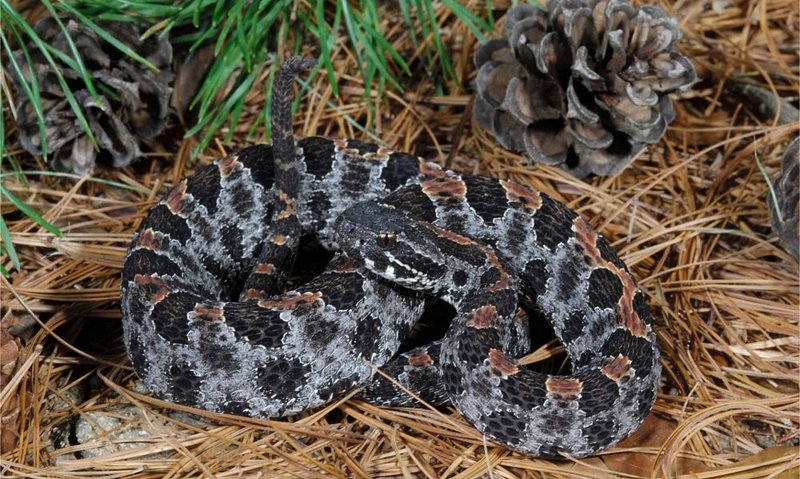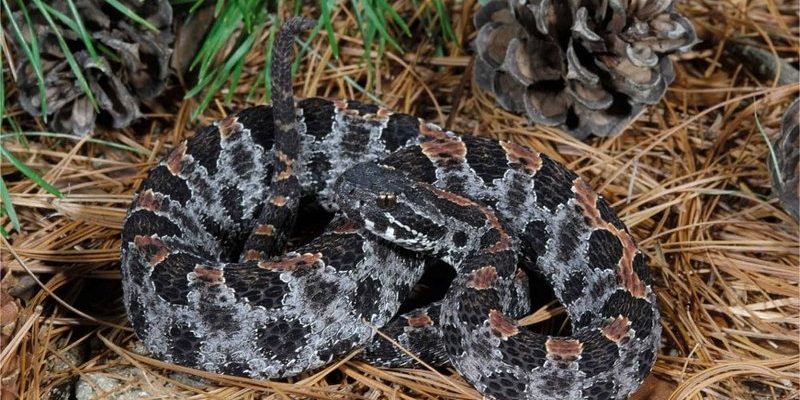
The Pygmy Rattlesnake may not be the biggest snake out there, but it surely has a personality that packs a punch! Imagine a tiny, yet striking creature that moves with an elegant stealth, blending into its surroundings with remarkable ease. This little rattler might be the perfect example of “good things come in small packages,” and that’s just one of the many reasons we should get to know it better. Let’s dive into the life of this captivating serpent and explore everything from its habitat to its behavior.
These snakes are kind of like the introverts of the reptile world. They don’t seek the limelight, preferring to stay hidden in the underbrush or leaf litter. You’ll often find them basking in the sun, recharging like a phone on a charging dock, before they hunt for their meals. If you’re curious about their lifestyle, habits, and what makes them unique, you’re in the right place!
What is a Pygmy Rattlesnake?
The Pygmy Rattlesnake (Sistrurus miliarius) is a small species of rattlesnake found primarily in the southeastern United States. They only grow to about 18 to 30 inches long, making them one of the smallest rattlesnake species. These snakes are often recognized by their distinct coloration, which can range from grayish-brown to a more vibrant rusty hue, adorned with beautiful dark bands that help them camouflage in their natural habitat.
One of the most fascinating aspects of the Pygmy Rattlesnake is its rattle—though it may be small, it can still produce a surprisingly loud sound when threatened. Think of it as a tiny alarm system, warning potential predators or curious humans to back off. They are often mistaken for other non-venomous snakes due to their coloration, but a closer look can reveal their telltale rattle and unique facial markings.
While they might look similar to other snakes, the Pygmy Rattlesnake has its own quirks. Its temperament is generally elusive, preferring to avoid confrontation. They are nocturnal hunters, often becoming active at night when the temperatures are cooler. So, if you ever venture into their habitat, you might need a little luck to spot one!
Habitat and Range
Pygmy Rattlesnakes primarily inhabit diverse environments, including pine forests, wetlands, and grassy fields. Their range stretches across parts of the southeastern U.S., from Florida all the way to Texas. They tend to favor areas with ample cover, such as leaf litter or dense vegetation, which provides both safety from predators and a chance to ambush their prey.
When you think about their habitat, picture a sun-drenched forest floor sprinkled with fallen leaves and wildflowers. This is where these snakes thrive, blending seamlessly with their surroundings. The vibrant colors and patterns of their scales allow them to remain hidden from both prey and predators alike, enhancing their chances of survival in the wild.
Climate plays a significant role in their habitat preferences. Pygmy Rattlesnakes tend to favor warm, humid environments, often retreating to burrows or crevices during cooler months. This behavioral adaptation helps them maintain their body temperature, ensuring they can hunt effectively when the time comes.
Diet and Feeding Habits
The diet of a Pygmy Rattlesnake is quite fascinating. These small predators primarily feed on rodents and other small mammals, such as mice and shrews. Their venom is specialized to quickly subdue these prey items, making it easier for them to consume their meals. Picture a tiny ninja, stealthily hunting in the shadows, ready to strike at a moment’s notice.
Feeding often occurs at night, which is when these snakes are most active. They rely on their keen sense of smell and heat-sensing pits located on their faces to detect warm-blooded prey. Once they’ve located a meal, they strike with precision and inject venom to immobilize their target. After the prey is subdued, they swallow it whole, which is quite a sight to behold!
Interestingly, Pygmy Rattlesnakes can go several days or even weeks without eating, depending on their energy expenditure and environmental conditions. This ability to survive without frequent meals is critical, especially in habitats where food may not always be readily available. It’s a testament to their adaptability and resilience in the wild.
Mating and Reproduction
The mating rituals of Pygmy Rattlesnakes are quite intriguing. Breeding typically occurs in late summer or early fall, and males often compete for the attention of females by engaging in some rather interesting behaviors. Think of it like a dance-off, where the snakes twist and coil around each other in a show of strength and agility.
After mating, female Pygmy Rattlesnakes can give birth to anywhere from 4 to 12 live young, usually in late summer. Unlike some snakes that lay eggs, these reptiles are ovoviviparous, meaning the young develop inside the female and are born as miniature versions of adults. So, when you see a baby Pygmy Rattlesnake, it’s just a smaller rattle with an attitude!
Newborns are independent from the moment they are born and will begin to search for food almost immediately. This independence is crucial for their survival, as they must fend for themselves in the wild. Their small size and striking appearance mean they have to be cautious and clever to evade predators during these early stages of life.
Behavior and Temperament
The overall temperament of the Pygmy Rattlesnake is generally shy and secretive. When threatened, they often prefer to flee rather than confront potential danger. However, if cornered, they won’t hesitate to rattle their tails as a warning signal. This rattle, though not always loud, is a reminder that they deserve respect and space.
You might be surprised to learn that these snakes exhibit a range of behaviors depending on their surroundings. For instance, if they feel safe in their environment, they might bask in the sun, soaking up the warmth. However, if they sense a potential threat, they’ll quickly retreat into the underbrush, demonstrating their preference for a low-profile lifestyle. It’s as if they have a built-in radar for danger, helping them avoid confrontations whenever possible.
Despite their secretive nature, Pygmy Rattlesnakes contribute to the ecosystem. By keeping rodent populations in check, they help maintain a balance between species in their habitat. So, even though you might not see them often, they’re playing a vital role behind the scenes—much like unsung heroes in the wild!
Conservation Status
While the Pygmy Rattlesnake is not currently classified as endangered, they face threats like habitat loss and human interaction, which can have significant impacts on local populations. As development encroaches on their habitats, these snakes often find themselves squeezed into smaller and smaller areas, making survival more challenging.
Additionally, road mortality is a concern, as these snakes may not always be able to escape vehicles. Conservation efforts, such as habitat preservation and public education, play a crucial role in ensuring the survival of this unique species. Raising awareness about their importance in the ecosystem can lead to more protective measures, benefiting not only the Pygmy Rattlesnake but the entire environment.
As a landowner or outdoor enthusiast, you can also help by respecting natural habitats and advocating for local wildlife. Remember, every little action counts, and protecting these fascinating creatures ensures they can continue to thrive in the wild.
Interesting Facts About Pygmy Rattlesnakes
| Common Name: | Pygmy Rattlesnake |
| Scientific Name: | Sistrurus miliarius |
| Size: | 18–30 inches |
| Habitat: | Pine forests, wetlands, grassy fields |
| Diet: | Rodents, small mammals |
| Reproduction: | Live birth, 4–12 young |
| Lifespan: | Up to 10 years in the wild |
FAQ
Are Pygmy Rattlesnakes dangerous to humans?
While Pygmy Rattlesnakes are venomous, they are generally not considered a significant threat to humans. Their bites can be painful and may require medical attention, but they tend to prefer avoiding confrontation. If you encounter one, it’s best to keep your distance and observe from afar.
How can I identify a Pygmy Rattlesnake?
Pygmy Rattlesnakes are relatively small, with distinctive markings that vary from grayish-brown to rusty hues. They feature a rattle at the end of their tail, though it may be small and subtle. You can distinguish them from other snakes by their triangular heads and the unique pattern on their bodies.
What do Pygmy Rattlesnakes eat?
These snakes primarily feed on small rodents such as mice and shrews. They have specialized venom that helps immobilize their prey quickly, allowing them to consume it whole. Their hunting skills are quite impressive, as they rely on stealth and their ability to blend into their surroundings.
Where do Pygmy Rattlesnakes live?
Pygmy Rattlesnakes are found mainly in the southeastern United States, inhabiting environments like pine forests, wetlands, and grassy areas. They prefer habitats with plenty of cover, which helps them stay hidden from both predators and unsuspecting prey.
How do Pygmy Rattlesnakes reproduce?
Unlike some snakes that lay eggs, Pygmy Rattlesnakes give birth to live young, typically in late summer. The females can produce anywhere from 4 to 12 offspring, which are independent from the moment of birth and must quickly learn to fend for themselves.
What is the lifespan of a Pygmy Rattlesnake?
In the wild, Pygmy Rattlesnakes can live up to 10 years, depending on factors like predation and environmental conditions. Their lifespan can vary based on their habitat and the availability of food, but they are generally a resilient species.
Can Pygmy Rattlesnakes be kept as pets?
While some people do keep Pygmy Rattlesnakes as exotic pets, it’s essential to note that they require specialized care and conditions. Additionally, they are wild animals, and their natural behaviors might not translate well to captivity. Always check local regulations and ensure you have the necessary knowledge before considering a Pygmy Rattlesnake as a pet.
How can I help conserve Pygmy Rattlesnakes?
You can play a significant role in conserving Pygmy Rattlesnakes by protecting their habitats and advocating for wildlife conservation. Simple actions like respecting nature, supporting habitat preservation initiatives, and educating others about these fascinating snakes can contribute to their survival.
Are Pygmy Rattlesnakes solitary or social creatures?
Pygmy Rattlesnakes are generally solitary animals. They prefer to hunt and live alone, only coming together during the mating season. Their independent nature helps them thrive in their habitats while avoiding competition for resources.
What should I do if I encounter a Pygmy Rattlesnake?
If you cross paths with a Pygmy Rattlesnake, it’s best to remain calm and give it space. They typically prefer to avoid humans, so slowly backing away is usually the safest choice. If you’re in an area where they are common, it’s wise to be cautious and watch where you step.

